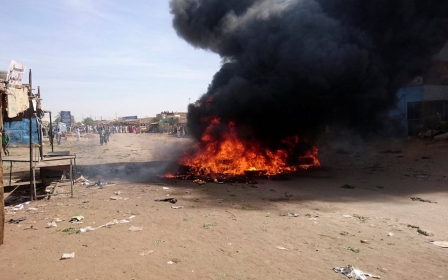Protesters marching on Sudan presidential palace met by live fire, tear gas
Sudanese forces reportedly used live fire against protesters who gathered in the centre of the capital Khartoum and around the country on Monday demanding the fall of President Omar al-Bashir after almost 30 years in power.
For a second week, the Sudanese Professionals Association, an independent trade union, called for a march on the presidential palace. The march is part of a wave of protests ignited by frustrations over rising living costs and government policies.
The Sudanese Doctors Committee, which has supported the strike, said protesters are being treated for injuries from live fire and tear gas, but there had not been any deaths.
Live streams showed crowds of hundreds gathered in different areas of Khartoum - on one occasion sitting down in front of the security forces and chanting "peacefully" before tear gas was fired at them and pick-up trucks with armed troops charged forward as the sound of weapons firing rang out in the background.
There were widespread reports of security forces assaulting and detaining people filming the protests, including journalists.
"I was caught secretly filming a convoy of armed national security trucks and they attacked us. They banged on the car doors with batons screaming 'give us the camera!'. When I opened the door, one guy grabbed me by the shirt and screamed in my face to hand over the phone," tweeted journalist Yousra Elbagir.
"He ripped my shirt open and one officer went around and grabbed the cameraman in the drivers seat and hit him. They kept screaming until I gave them my local phone that has no sensitive information or footage and they released us after giving the cameraman a final smack."
Rolling protests
Last week Sudanese journalists launched a three-day strike to demonstrate against government censorship of media covering the protests, which has included confiscations of newspapers and the arrest of several journalists around the country.
According to officials, at least 19 people have been killed during almost two weeks of protests but numbers have varied. Amnesty International estimated at least 37 people were killed during the first few days of demonstrations.
The protests erupted in the northeastern city of Atbara when the ruling National Congress Party's offices were torched by Sudanese angry at the tripling of bread prices and austerity measures imposed by Bashir.
The economy has struggled since South Sudan's seceded in 2011, depriving Sudan of three-quarters of its oil output.
Bashir has attempted to implement measures to help alleviate the economic situation. However the government's 2018 budget came under scrutiny after it was revealed that 14 percent was allocated to security spending compared to just three percent for education.
"We will march towards the presidential palace calling for President Omar al-Bashir to step down," the Sudanese Professionals' Association said in a statement late Sunday.
During protests called by the association last Tuesday, Bashir reportedly had to cut short a trip to central Sudan where footage shared on social media showed protesters jeering his convoy as it sped away.
Opposition groups and prominent rebel chief Abdel Wahid al-Nur from war-torn Darfur have also urged their supporters to participate in the march.
On Sunday, Bashir met top police officers in Khartoum and instructed them to refrain from using excessive force against demonstrators after the United Nations called for an investigation into the deaths and violence during the demonstrations.
"We want to maintain security and we want the police to do that by using less force," Bashir said.
Middle East Eye propose une couverture et une analyse indépendantes et incomparables du Moyen-Orient, de l’Afrique du Nord et d’autres régions du monde. Pour en savoir plus sur la reprise de ce contenu et les frais qui s’appliquent, veuillez remplir ce formulaire [en anglais]. Pour en savoir plus sur MEE, cliquez ici [en anglais].




